

Article of the Month - August 2020 |
Naa Lamkai Quaye-Ballard, Daniel Asenso-Gyambibi and Jonathan Quaye-Ballard, Ghana
 |
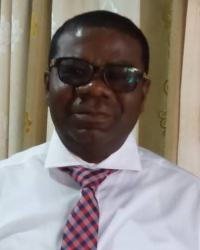 |
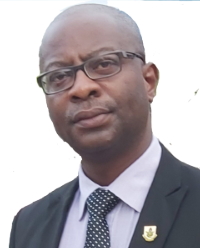 |
| Naa Lamkai Quaye-Ballard | Daniel Asenso-Gyambibi | Jonathan Quaye-Ballard |
This article in .pdf-format (14 pages)
The use of Unmanned Aerial Vehicles (UAVs) for remote data acquisition has rapidly evolved in recent years. The integration of UAV with Global Positioning System (GPS) and Geographic Information System (GIS) techniques have reduced time and cost in acquiring data for inaccessible land areas. Topographical mapping of water bodies, marshy areas or land areas without land cover using traditional methods of surveying in Ghana is time consuming and challenging. This study considered topographical mapping of muddy Tailings Storage Facility (TSF) sites at a rain forest mining area at Osino in the Eastern Region of Ghana. DJI Phantom 4 Pro consumer UAV was flown at an altitude of 75m in a 3D flight mode. Real Time Kinematic (RTK) GPS was used to coordinate a reflective-marked Ground Control Point (GCP). Georeferencing the orthophoto was done using the GCP. Digital Terrain Model (DTM) was generated from the processed orthophotos after which contours at 5 m interval were generated. Cross sections across the TSF were drawn for further geotechnical and stability analysis for the tailings dam. The accuracy of the topographic map is below 5 cm and confirms the suitability of using consumer grade UAVs for topographical mapping of inaccessible areas in a cost-effective manner. Thus, the integration of RTK technology with the UAV and GIS is a feasible and appropriately accurate solution for mapping inaccessible areas.
Topographical surveying is mostly required by Engineers and Architects to aid in infrastructural designs and construction. Topographical maps are used for planning, monitoring and development of infrastructure in Ghana. Geomatic Engineers are professionally required to undertake the topographic surveying in accordance with the code of ethics of the Ghana Institution of Surveyors (GhIS) and the standards from the Survey and Mapping Division (SMD) of the Lands Commission of Ghana. Due to the high cost of topographical surveying, unprofessional Surveyors are either hired or even not involved in infrastructural development and planning. This is evident in the haphazard infrastructural development in Ghana resulting in persistent flooding after rainfall and collapse of buildings especially in the urban areas like Accra, Kumasi. Professional land Surveyors in Ghana are constantly researching on cost effective methods of surveying in order to achieve Sustainable Development Goals (SDG) 9 and 11 (Terah Antwi et al., 2020). To undertake a topographical survey, considerations must be made on the purpose, map use, scale, size and terrain involved, cost, equipment to be used, duration and surveyor’s experience (Ghilani & Wolf, 2012). General mapping surveying is done by either ground and photogrammetric methods or both (Ghilani & Wolf, 2012). The most common survey instruments in Ghana are the Total Station and Global Positioning System (GPS). Topographical mapping of water bodies, water-logged areas or land areas without land cover using traditional methods of surveying in Ghana is time consuming and challenging. To map out swampy areas, flooded areas or any area without getting in contact with the land surface have been daunting tasks with high cost of operation and risk to the surveyor. Photogrammetry methods, remote sensing data, scanners and LiDAR mapping have been the available accurate way of mapping such areas (Jalayer et al., 2015; Lato et al., 2015; Lim et al., 2003; Tang & Shao, 2015). These surveying methods are, however, very expensive to undertake.
The Land Surveying profession is constantly searching for fast and cost-effective ways of surveying inaccessible area for years (Casagli et al., 2017; Malehmir et al., 2016; Quaye-Ballard et al., 2013). In recent times, the use of UAVs in surveying is being practiced worldwide (Christiansen et al., 2017; Gonzalez et al., 2016; Turner et al., 2016). UAVs, specially built with on board high accuracy GPS and specifically built for mapping are available, but at a high cost. However, consumer grade UAVs which are cheaper, simple to use and easily available with multiple uses including photography, delivery, agriculture and surveillance, are being used with the aid of GPS and Ground Control Point (GCP) for topographical surveying (Aleshin et al., 2019). UAVs survey uses photogrammetry methods with an output of orthophotos which are geo-referenced and further processed for geographic data with the aid of software. UAVs also used for vegetation cover estimation (e.g. Chen et al., 2016; Ghazal et al., 2015; Torres-Sánchez et al., 2014) as well as river topography and vegetation (Watanabe & Kawahara, 2016). Orthophotos give a pictorial view of the site which makes planning and analysis easier, unlike conventional surveying methods where sketches and pictures are taken in addition.
The Land Surveying profession is constantly searching for fast and cost-effective ways of surveying inaccessible area for years (Casagli et al., 2017; Malehmir et al., 2016; Quaye-Ballard et al., 2013). In recent times, the use of UAVs in surveying is being practiced worldwide (Christiansen et al., 2017; Gonzalez et al., 2016; Turner et al., 2016). UAVs, specially built with on board high accuracy GPS and specifically built for mapping are available, but at a high cost. However, consumer grade UAVs which are cheaper, simple to use and easily available with multiple uses including photography, delivery, agriculture and surveillance, are being used with the aid of GPS and Ground Control Point (GCP) for topographical surveying (Aleshin et al., 2019). UAVs survey uses photogrammetry methods with an output of orthophotos which are geo-referenced and further processed for geographic data with the aid of software. UAVs also used for vegetation cover estimation (e.g. Chen et al., 2016; Ghazal et al., 2015; Torres-Sánchez et al., 2014) as well as river topography and vegetation (Watanabe & Kawahara, 2016). Orthophotos give a pictorial view of the site which makes planning and analysis easier, unlike conventional surveying methods where sketches and pictures are taken in addition.
This study examines the suitability and accuracy of a topographical survey conducted with the combination of RTK-GPS instrument and a consumer grade UAV at an inaccessible tailings dam at Osino in the Eastern Region of Ghana to produce cross sections and contours for design and construction of tailings storage facility (TSF). TSF are earth-filled embankment dam that are used to store byproducts of mining operation (Choi & Song, 2016; Wang, 2017; Yakubu et al., 2019). Mining areas located at Osino and Asiakwa in the Eastern Region of Ghana are within the valley flats of the Birim sub-basin of the Pra River. The region is dominated with heavy rainfall during the rainy seasons in Ghana. Due to the fact that TSFs are earth-filled, heavy rainfall renders the dam walls weak, muddy and inaccessible. An unstable TSF may collapse and cause environmental pollution, loss of life and property Wang (2017). Geotechnical investigation and stability analysis test are periodically done in order to check the condition of the dams, redesign and reconstruct to improve productivity and safety (Attewill et al., 2004; Brown & Hewitt, 2016; Dong et al., 2019). TSF geotechnical investigations require a topographical survey with Digital Terrain Model (DTM) and contours for generating cross sectional drawings of the dam for stability analysis test (Pastor et al., 2015; Torgoev, 2017).

Figure 1: Flowchart of methods and data processing
A site visit was done to plan the best way to undertake the studies. The Survey and Mapping Division (SMD) of the Lands Commission of Ghana was visited to seek locations and coordinates of National benchmarks closer to the study location. A desk study was done by studying Google and Topographical maps of Ghana.
From National benchmarks provided by the SMD, a total of four concrete Temporal Benchmarks (TBM) were established using static GPS surveying method. A vehicle screen shield which costs less than a dollar together with a masking tape was used as a reflective material for GCP (Figure 2). Six GCPs were established near the tailings dam via static GPS surveying method.
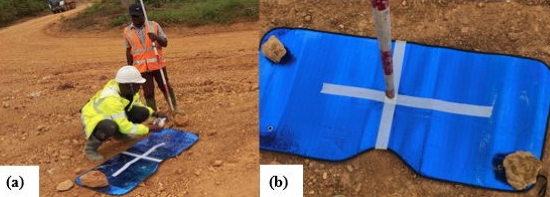
Figure 2: (a) Team constructing relective material ; and (b) Reflective material used as GCP
RTK-GPS survey was carried out in a semi-kinematic or the stop-and-go mode to improve the accuracy of data of geographic details at locations that were easily accessible by the team (Figure 3). Spot heights across the TSF at notable locations were also taken. Two (2) points were taken on reflective materials to be used as validating points.
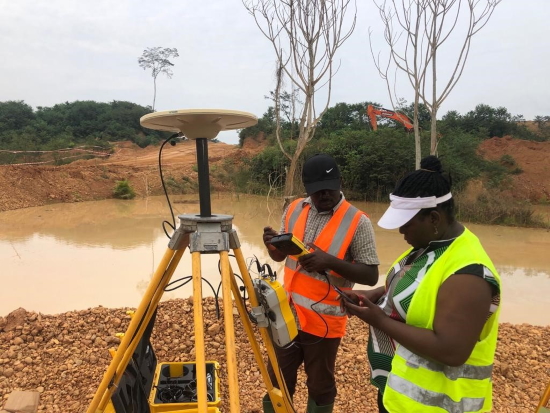
Figure 3: GPS-RTK Survey
2.4 UAV Survey
Flight plan (Figure 4a) was designed to determine the area and path for the UAV survey (Figure 4b). The UAV was set to enhanced 3D mode. The selected flight height was seventy-five meters with approximately fourteen (14) minutes flight duration using three batteries for an extended area of 160,000 sqm. Duration of both GPS-RTK and UAV survey was a day for an actual area of approximately 50,000sqm.
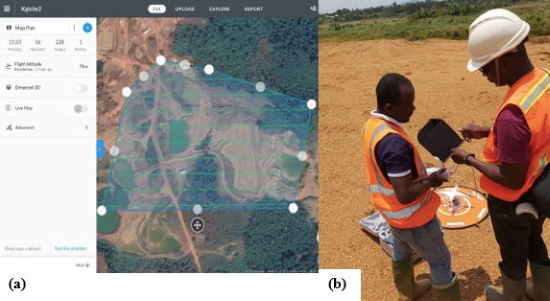
Figure 4: (a) Flight Plan; and (b) UAV survey
2.5 Data Processing
The RTK-GPS data was downloaded and processed. UAV data was also downloaded and processed using a Photogrammetric and image processing software. GCP coordinates (Figure 5a) were imported into the software for georeferencing (Figure 5b) the orthophotos.

Figure 5: (a) GCP on Orthophoto; and (b) Georeferencing GCP
A dense cloud, mesh textured tiled model was created from which a DTM was generated. The file was exported into a GIS software for digitizing the geometry of the TSF (Figure 6a) and further analysis. Points were picked on the orthophoto to compare with the GPS-RTK validating points as well as the water levels. The digitised geometry of the TSF includes the inner bottom perimeter, the toe perimeter, the top outer and inner edge perimeter. Additional coordinates for spot heights and geometry needed to draw cross-sections across the TSF were extracted on the orthophoto in the GIS software and exported to a Computer Aided Design (CAD) software (Figure 6b). The GPS-RTK coordinates were also imported into the CAD software.

Figure 6: (a) Digitising boundaries of tailings dam; and (b) Point generation in GIS software
All GPS-RTK points and the generated points from the orthophoto were imported into the CAD software. The digitised TSF geometry lines were also imported and refined with imported additional points. The duration of data processing and plotting lasted a day.
The orthophoto showing TSF and surroundings in 3D is shown in Figure 7.
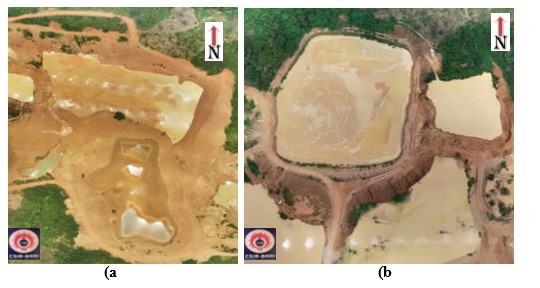
Figure 7: (a) Orthophotos of TSF sites (b) 3D projection of TSF
The GPS-RTK coordinates of GCPs used in geo-referencing the othophoto are shown in the table below (Table 1)
Table 1: Coordinates of GCPs

Validating GPS-RTK points compared to the points picked on the processed orthophoto are shown in table 3. From table 3, the highest difference recorded was 4.3cm in elevations and 4.7cm in Eastings
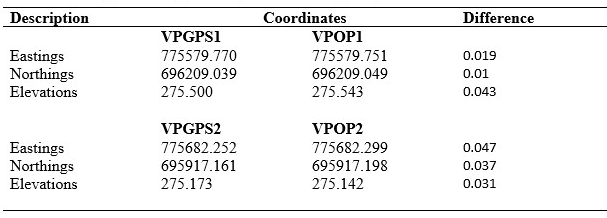
Required information was drawn and shown on a standard topographical map with a scale 1:100 (figure 8).
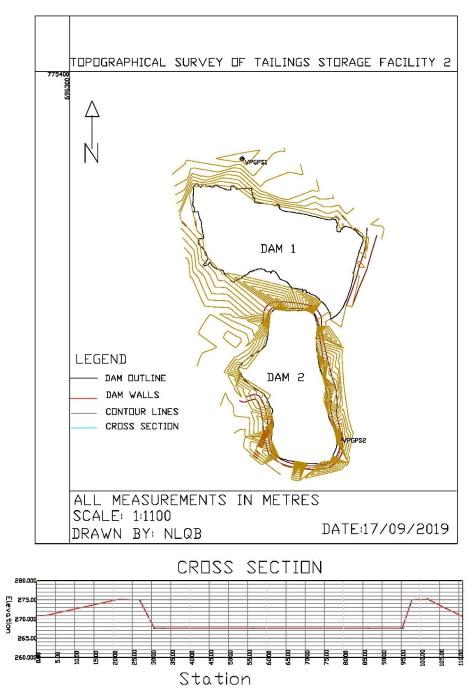
Figure 8: Topographical Map showing TSF geometry and Cross section of TSF
A surface was created from both GPS-RTK points and generated points from the orthophotos in the CAD software. From the triangulation, contours at 5m intervals were generated. Cross sections through each TSF were drawn (figure 8).
The accuracy of the topographic map was below 5 cm and confirms the suitability of integrating consumer grade UAVs with GPS and GIS for topographical mapping of inaccessible areas in a cost-effective manner. It was cost effective because it took comparatively shorter period for topographical mapping. Field work was drastically reduced. The data was sufficient and accurate enough to design a TSF for sustainable mining activities and investigations. It was also useful for siting piezometers for geotechnical investigations. Consumer grade UAV is recommended for topographical survey especially for inaccessible areas. UAVs are recommended for the production of acurrate geometry and cross-sectional drawings for design, geotechnical analysis of slope stability of TSFs.
Aleshin, M., Gavrilova, L., & Melnikov, A. (2019). Use of unmanned aerial vehicles on example of Phantom 4 (standard) for creating digital terrain models. Engineering for Rural Development, 22, 1686–1692.
Daniel Asenso-Gyambibi
Ing. Surv. Daniel Asenso-Gyambibi is the Director of the CSIR-Building and Road Research Institute, Ghana. His research areas are land administration, GIS and Mapping. He has 23 years work experience, working on a number of projects of national importance including the Ghana Lana Administration Project (LAP), mapping of degraded mine site and reclamation activities, preparation of schemes for urban renewal, perfecting rural land title, hydrographic surveys, mine surveys, GIS in health, transport, mining and agricultural development etc. Daniel's wide experience is as a result of his involvement in projects with varied professionals in the Built Environment. He is a PhD candidate in Geomatic Engineering. He holds an MPhil and BSc in Geomatic Engineering from the Kwame Nkrumah University of Science and Technology, Ghana., Ghana. He is a member of Ghana Institution of Surveyors and Ghana Institution of Engineering.
Jonathan Arthur Quaye-Ballard
Senior Lecturer and Head of Department of Geomatic Engineering, KNUST, Kumasi, Ghana. Holds BSc. Geodetic Engineering from KNUST, Kumasi, Ghana; MSc. Geo-Information Science and Earth Observation from ITC, Enschede, Netherlands; and PhD. Geodesy and Survey Engineering from Hohai University, Nanjing, China. A Licensed Surveyor and member of Ghana Institution of Surveyors (GhIS) and Ghana Institution of Engineering (GhIE). Research interest are Usability Testing; Applications of Geographic Information Systems (GIS) and Remote Sensing (RS) for environmental resource management and analysis; Cartographic Visualization; Systems Analysis; and Computer Supported Collaborative Learning (CSCL).
Ing. Surv. Naa Lamkai Quaye-Ballard
Council for Scientific and Industrial Research (CSIR)
Building and Road Research Institute (BRRI)
P. O. Box UP40 Kumasi
Ghana
Ing. Surv. Daniel Asenso-Gyambibi
Council for Scientific and Industrial Research (CSIR)
Building and Road Research Institute (BRRI)
P. O. Box UP40 Kumasi
Ghana
Dr. Jonathan Arthur Quaye-Ballard
Department of Geomatic Engineering
Kwame Nkrumah University of Science and Technology (KNUST)
Kumasi
Ghana
Web site: www.knust.edu.gh